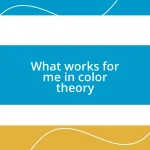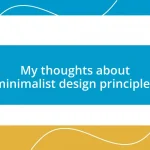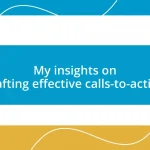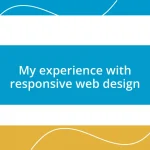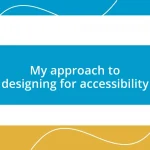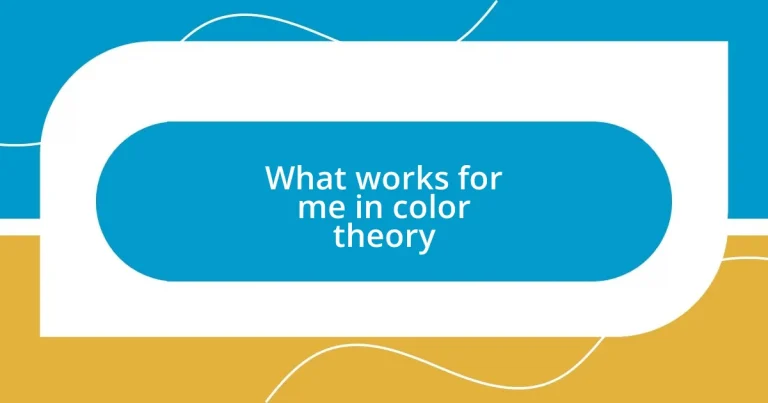Key takeaways:
- Understanding color theory enhances visual impact through complementary and harmonious color interactions.
- Choosing an effective color palette requires defining the desired mood, considering context, and experimenting with limited color combinations.
- Utilizing color harmony techniques, such as triadic and complementary schemes, creates dynamic energy and emotional resonance in art and design.
- Reflecting on personal experiences with color reveals its profound ability to shape feelings and transform spaces, serving as a powerful emotional language.
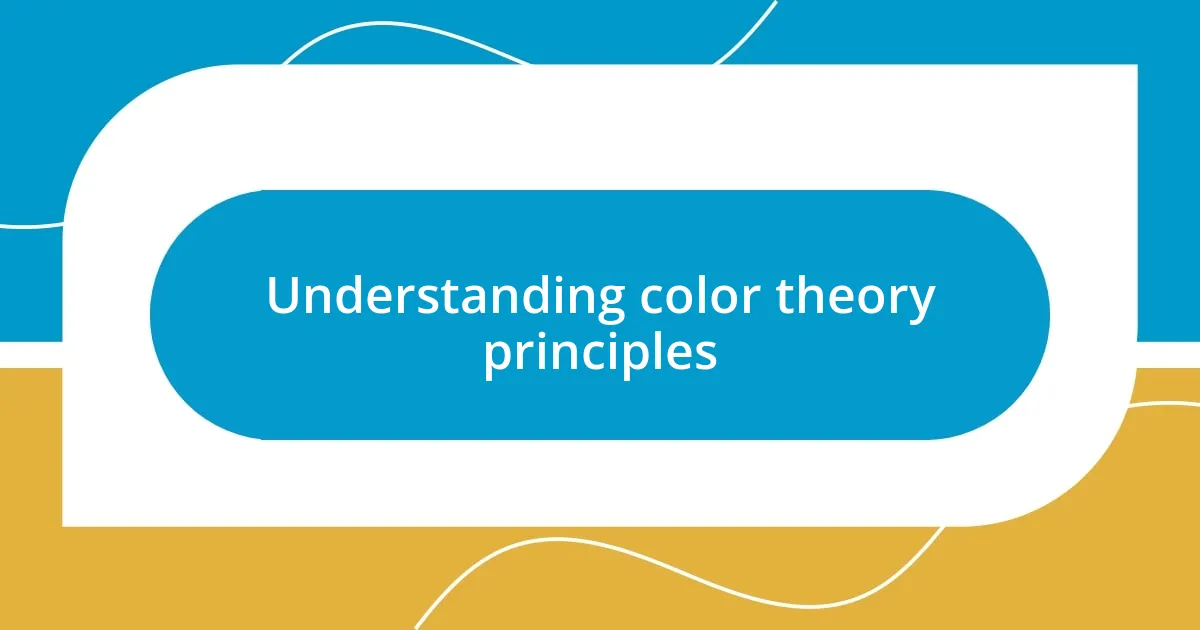
Understanding color theory principles
Color theory is like the secret language of art and design. When I first dipped my toes into the world of color, I was struck by how colors interact with each other. Have you ever noticed how an orange shade can vibrate against a blue? This phenomenon, known as complementary colors, instantly drew me in and enhanced my understanding of creating vibrant visuals.
I remember a project where I had to balance warm and cool colors in a painting. It was fascinating to learn how warm colors, like reds and yellows, can evoke feelings of warmth and excitement, while cool colors, such as blues and greens, create a sense of calm and serenity. Has this happened to you? Understanding how to use these principles not only shaped my color choices but also amplified the emotional resonance of my work.
The color wheel is perhaps the most essential tool I’ve used in grasping color theory principles. It helped me see relationships between colors—like analogous colors that sit next to each other and create harmony. Each time I explore with these concepts, I find new ways to express my ideas. How do you incorporate these theories in your creations? I’d love to hear your experiences!
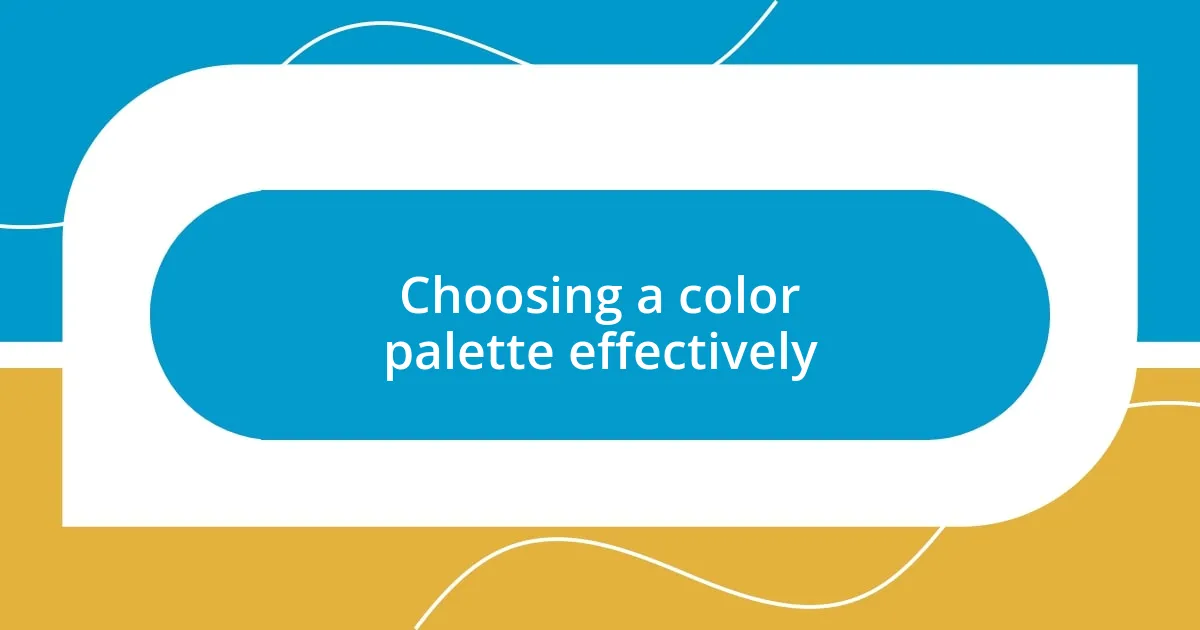
Choosing a color palette effectively
Choosing a color palette effectively involves understanding the mood and message you want to convey. I recall selecting colors for a community mural I participated in; I aimed for a joyful and inviting atmosphere. By choosing bright yellows and vibrant pinks alongside softer greens, we managed to create a lively yet harmonious composition that elicited smiles from everyone who passed by. It’s amazing how a well-thought-out palette can transform a simple space into an engaging experience.
When picking a color palette, several strategies can guide your decisions:
- Define the Emotion: Decide on the feelings you want to evoke. Energetic, calm, romantic?
- Context Matters: Consider where your colors will be displayed—indoors or outdoors, bright or dimly lit.
- Limit Your Palette: Stick to a few colors to maintain harmony and avoid overwhelming the viewer.
- Experiment and Iterate: Try out various combinations and tweak them based on feedback and your own feelings.
- Use Tools and Resources: Online color palette generators can spark inspiration and provide variations on your chosen themes.
In my experience, trusting my instincts while balancing guidance from tools has resulted in some of my favorite projects. I find that the best palettes are often discovered through exploration rather than rigid planning.
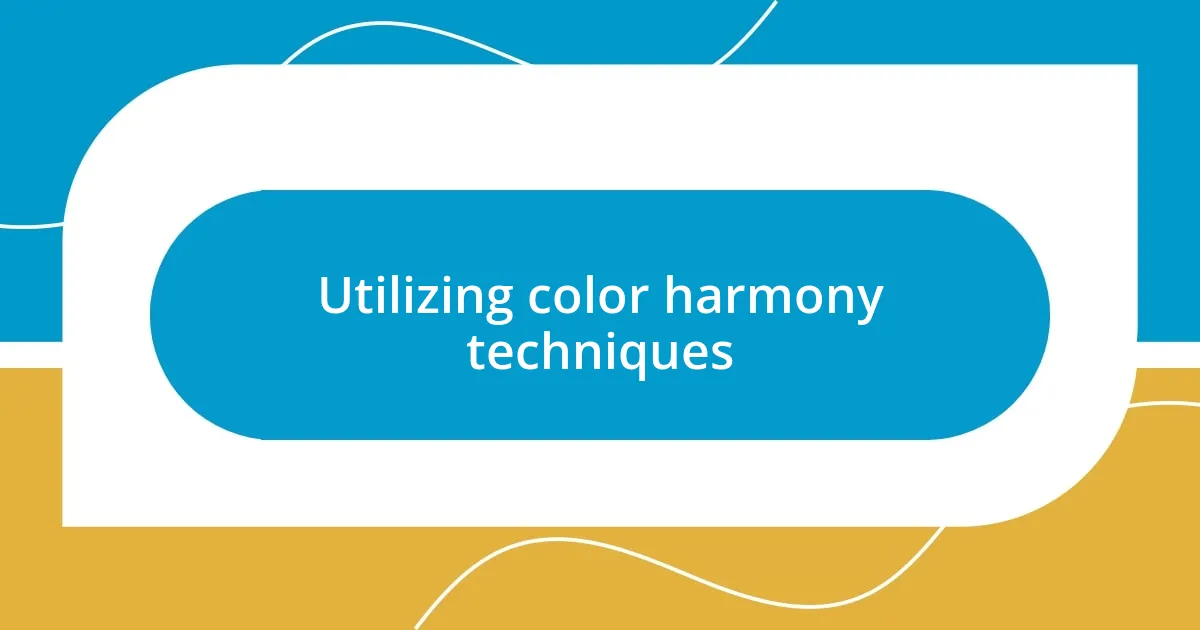
Utilizing color harmony techniques
Utilizing color harmony techniques is a game-changer in any artistic endeavor. One technique I find particularly effective is the use of triadic color schemes, which involve three colors that are evenly spaced on the color wheel. I recall experimenting with this technique for an abstract piece; the interplay between vibrant red, yellow, and blue created a dynamic energy that truly captivated viewers. It reminded me that harmony doesn’t mean matching, but rather finding balance in variety.
Another approach I often use is the complementary scheme. I remember one project where I wanted to convey a sense of tension and excitement. Pairing a striking orange with a deep blue created that juxtaposition perfectly, making each color pop against the other. This contrast not only drew attention but also allowed the emotions of the moment to shine through. Does this kind of dramatic effect resonate with you? It certainly does for me.
Incorporating color harmony techniques isn’t just scientific; it’s deeply intuitive. I sometimes allow myself to experiment spontaneously, trusting my gut to create visual dialogues between colors. Has there been a time when you allowed colors to guide your creative process? I’d love to hear about those moments of inspiration!
| Color Harmony Technique | Description |
|---|---|
| Triadic Scheme | Utilizes three evenly spaced colors on the color wheel for a vibrant look. |
| Complementary Scheme | Combines opposing colors to create strong contrast and visual excitement. |
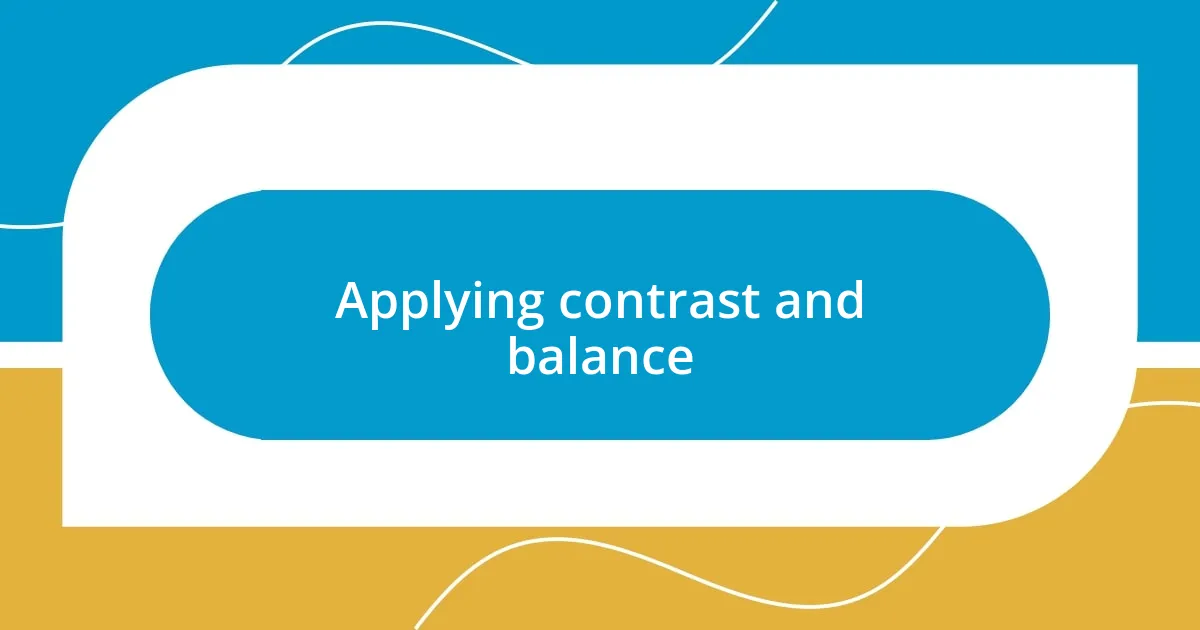
Applying contrast and balance
Applying contrast and balance in color theory can drastically impact the emotional response of your audience. I remember once designing a flyer for a local band; I used a bold, dark purple as a background. The bright yellow text immediately grabbed attention, demonstrating how contrast not only enhances legibility but also creates an energetic vibe. When choosing contrasts, think about not just what looks good, but how those choices communicate feelings.
Finding the right balance goes beyond just contrasting colors; it’s about composing a cohesive visual narrative. I once painted a room where I intentionally paired deep blue walls with warm wood accents. In that space, the blue felt calming, while the wood brought a sense of warmth and connection. It’s fascinating how balance can create a sense of harmony even in seemingly opposing colors. Have you ever noticed how certain combinations can make you feel at ease or invigorated, depending on their arrangement?
In my experience, dynamic contrast is best achieved by playing with proportions. For a community event, I once crafted a poster that featured bright splashes of color, but kept the text neutral and subtle. This not only made the colors pop more vibrantly but also provided a visual rest for the viewer’s eye. How do you balance bold choices with more subdued elements in your work? Finding that sweet spot can elevate your projects in unexpected ways.
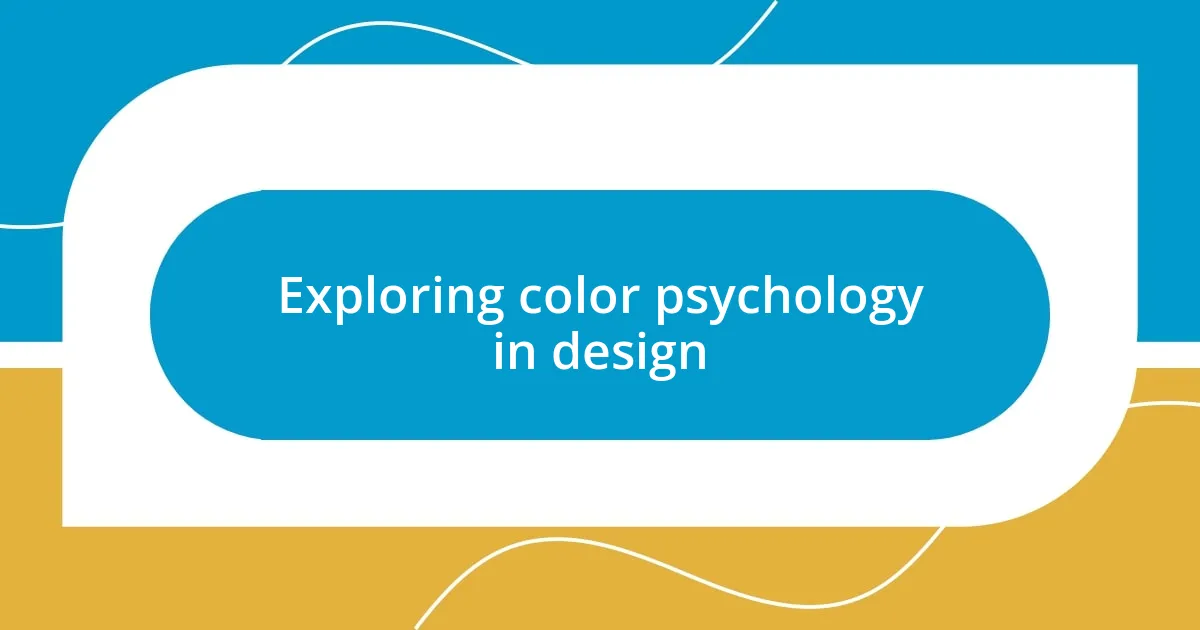
Exploring color psychology in design
Exploring color psychology in design opens up a rich tapestry of feelings and interpretations. I remember attending an art exhibit focused on blue tones. Each piece evoked tranquility, yet the varying shades told different stories. Some blues were calming and serene, while others felt cold and distant. It made me realize how much color can influence the mood of a viewer. Have you ever felt a certain way just by stepping into a room painted a specific color? It’s truly remarkable how deeply we respond to our surroundings.
One of my favorite projects involved designing a cozy café interior. I chose warm yellows and soft oranges to create an inviting atmosphere, hoping to encourage conversation and connection. The moment those colors were applied, the space transformed into a vibrant hub filled with laughter and warmth. This experience reinforced my belief that color isn’t just decoration; it’s a language of emotions. Have you noticed how a burst of yellow can uplift spirits? It’s like sunlight pouring in on a gloomy day.
Conversely, I’ve experimented with darker shades, like deep green and charcoal, in a minimalist office space. I wanted to evoke focus and professionalism. To my surprise, the feedback was overwhelmingly positive; the environment felt both sophisticated and calming. This really got me thinking – how can color work subtly to shape our thoughts and interactions? Exploring these nuances in color psychology can add layers of complexity to any design project, connecting with audiences on a profound level.
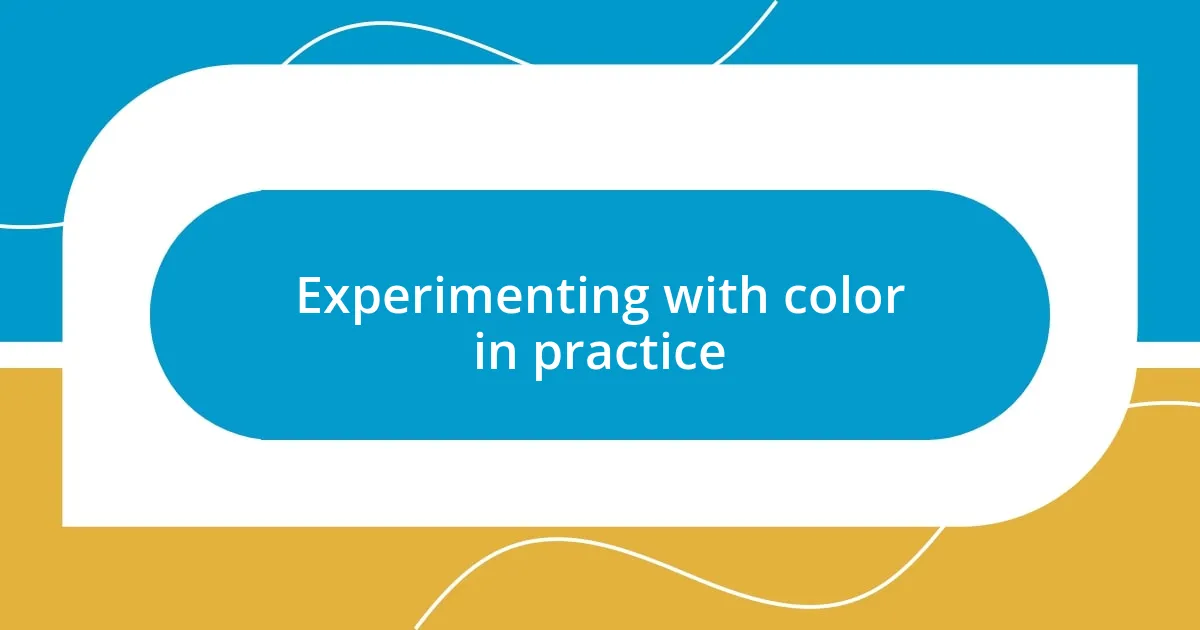
Experimenting with color in practice
When I first started experimenting with color, I thought slapping on some vibrant hues would be enough to create excitement. However, during a community mural project, I learned the importance of adjacent color combinations. I chose a lively green for the foliage but paired it with a softer blue sky. Not only did it bring balance, but it also created a sense of depth that I hadn’t anticipated. Have you ever tried mixing colors in unexpected ways and been pleasantly surprised by the outcome?
As I ventured deeper into color experimentation, I discovered the transformative power of layering. For a personal project, I layered transparent washes of red and orange over a neutral background, which led to a warm glow that looked different depending on the angle of light. It made me realize that color isn’t static—it can shift and change, much like our perceptions. Have you considered how layering can change your own work? It can add richness that mere flat colors might lack.
In another endeavor, I decided to break the rules of color harmony. I incorporated clashing colors in a local art show and watched people’s reactions unfold like a carefully orchestrated performance. The vibrant magentas alongside muted greens sparked conversations and debates, leading to a deeper connection among viewers. It taught me that sometimes, pushing boundaries can lead to beautiful dialogues. Have you ever taken a risk with color that turned out to be a conversation starter? Embracing unpredictability can open exciting creative avenues.
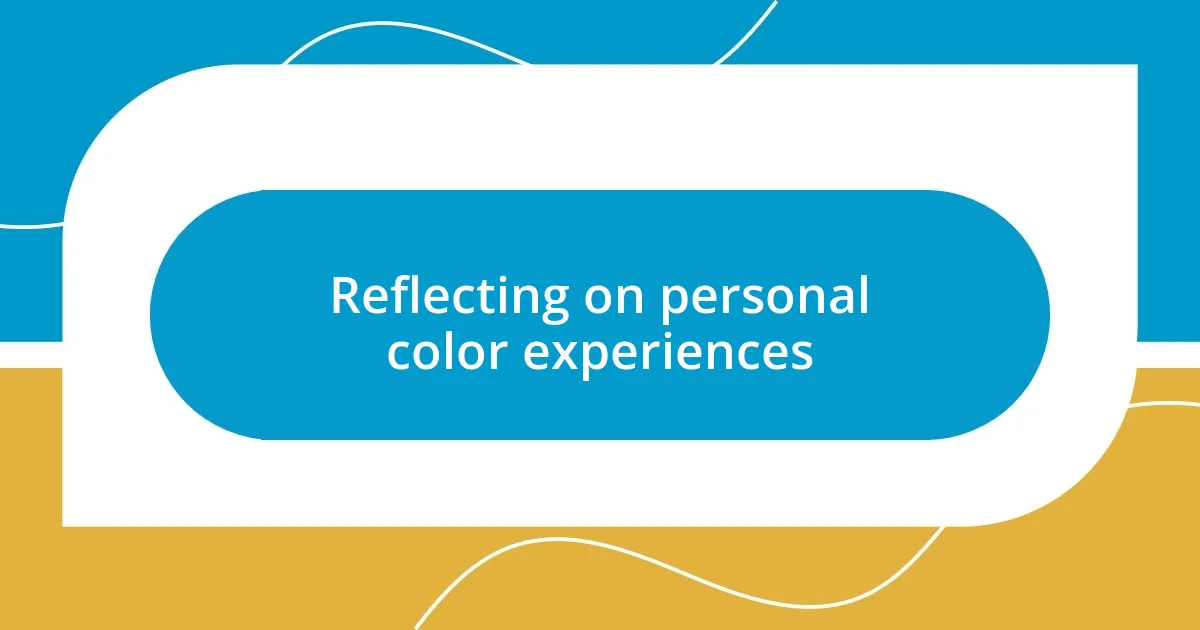
Reflecting on personal color experiences
Reflecting on my personal experiences with color brings back vivid memories of when I painted my bedroom walls a soft lavender. I initially chose it for its calming properties, but what surprised me was how it transformed my space into a sanctuary. Every time I entered, I felt an embrace of serenity, as if the room itself cradled me after a long day. Have you ever chosen a color that profoundly changed how you felt in a space? It’s an incredible testament to the emotional power of color.
On another occasion, while designing a friend’s garden, I opted for a burst of vibrant reds and yellows. As we stood back to admire our handiwork, a wave of joy washed over me when I noticed how the colors seemed to dance together under the sunlight. It was a profound reminder that color can inject life into our surroundings, creating energy that resonates with those who visit. Do you remember the first time a color made you smile unexpectedly?
I’ve also had moments where color choices took me by surprise. Once, I painted a small corner of my living room a daring teal, thinking it would spark creativity. While the color was undeniably bold, it also brought a sense of playfulness that I didn’t anticipate. I felt a surge of inspiration every time I entered that corner. Isn’t it fascinating how sometimes, the colors we think will have one effect can lead to an entirely different emotional response? Reflecting on these experiences reinforces my belief in color’s role not just in aesthetics, but in shaping our feelings and experiences within a space.
